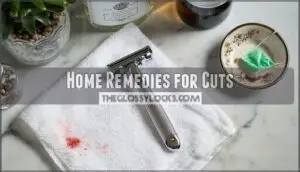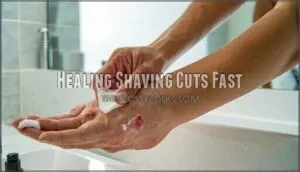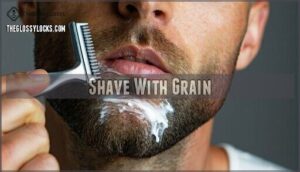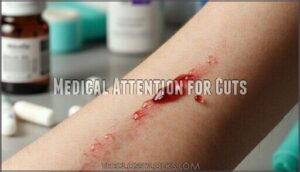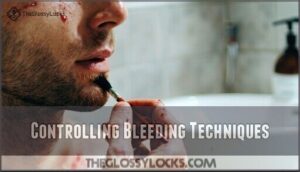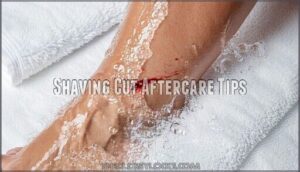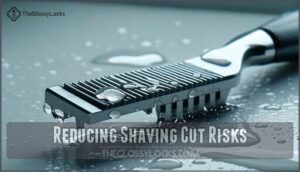This site is supported by our readers. We may earn a commission, at no cost to you, if you purchase through links.
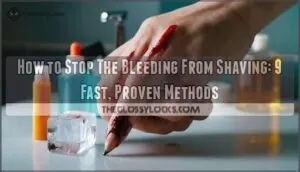
First, apply direct pressure using a clean tissue or cloth for 30-60 seconds. This simple step works like hitting the brakes on bleeding.
Next, grab an ice cube or cold compress to help blood vessels constrict and speed up clotting.
If you’re still seeing red, try a styptic pencil, alum block, or even lip balm to seal the cut. These household heroes can turn your morning mishap into a minor bump in the road.
Understanding how to stop the bleeding from shaving becomes second nature once you know which techniques work best for different situations.
Table Of Contents
- Key Takeaways
- Shaving Cut First Aid
- Stop Shaving Cut Bleeding
- Home Remedies for Cuts
- Healing Shaving Cuts Fast
- Preventing Shaving Cuts
- Medical Attention for Cuts
- Controlling Bleeding Techniques
- Shaving Cut Aftercare Tips
- Reducing Shaving Cut Risks
- Frequently Asked Questions (FAQs)
- How do you stop a shaving cut from bleeding?
- Do shaving cuts bleed a lot?
- How long does it take to stop bleeding from a shaving cut?
- Does a After Shave stop bleeding?
- How do you stop a cut from bleeding?
- Why does my shave bleed a lot?
- How to quickly stop bleeding from shaving?
- What do barbers use to stop bleeding?
- What should I do if I accidentally cut myself with a razor?
- Does alcohol stop bleeding from shaving?
- Conclusion
Key Takeaways
- Apply pressure immediately – Grab a clean tissue or cloth and press firmly on the cut for 30-60 seconds. Do not peek early, since this disrupts your body’s natural clotting process.
- Use cold to constrict blood vessels – Press an ice cube or cold compress against the cut for 15-30 seconds. The cold helps shrink blood vessels and speeds up clotting faster than pressure alone.
- Try household items as emergency fixes – You can use a styptic pencil, alum block, or even lip balm to seal cuts. These common items create a protective barrier that stops bleeding quickly.
- Prevent cuts with proper technique – Shave with the grain using a sharp razor and light pressure. Replace your razor blades every 5-7 shaves to avoid tugging that causes nicks and bleeding.
Shaving Cut First Aid
When you nick yourself while shaving, your first move should be to apply direct pressure to the cut with a clean cloth or tissue.
Press firmly with a clean cloth—don’t peek early, let your body’s clotting do the work.
You can also use a cold compress or ice to help constrict the blood vessels and reduce bleeding faster.
Apply Pressure Immediately
When blood starts flowing from a shaving cut, your first move is pressure application.
Grab a clean cloth or tissue and press firmly against the wound for at least 30 seconds.
This direct pressure activates your body’s natural clotting mechanisms, helping stop bleeding quickly.
Don’t peek too early—consistent pressure duration guarantees proper blood clotting and wound protection while you prevent irritation.
Use Cold Compress
Grab an ice cube or cold washcloth and press it against your shaving cuts for 15-30 seconds.
Cold water constricts blood vessels, which helps stop bleeding faster than pressure application alone.
The cold benefits include swelling reduction and pain management while promoting blood clotting.
You can use frozen peas or compress alternatives if ice isn’t available nearby.
Elevate Affected Area
Getting your cut above heart level works like magic for shaving cuts.
Gravity’s role helps reduce blood flow to the wound, making it easier to stop bleeding and reduce swelling.
Here’s how elevation improves circulation and healing:
- Sit down and prop your leg on a chair for ankle cuts
- Raise your arm above your shoulder for hand nicks
- Limit movement to prevent reopening minor cuts
- Hold position for 2-3 minutes minimum
- Combine with pressure for maximum first aid effectiveness
Stop Shaving Cut Bleeding
Three key factors determine how quickly your shaving cuts stop bleeding: pressure, time, and the right technique.
Quick bleeding control comes down to three essentials: steady pressure, patience, and proper technique.
When you nick yourself, your body’s clotting factors immediately spring into action, but you can speed up this natural process substantially.
The moment blood appears, apply direct pressure using a clean cloth or tissue.
Hold firmly for at least 30 seconds – don’t peek early, as this disrupts the clotting process.
For deeper shaving cuts, maintain pressure for up to two minutes.
This simple action helps your blood vessels constrict naturally while giving clotting factors time to work.
Here’s a quick reference for bleeding control timing:
| Cut Severity | Pressure Duration | Expected Results |
|---|---|---|
| Minor nicks | 30 seconds | Bleeding stops |
| Small cuts | 1-2 minutes | Noticeable reduction |
| Deeper cuts | 2-5 minutes | Controlled bleeding |
| Persistent bleeding | 5+ minutes | Seek medical help |
| Large wounds | Immediate care | Seek professional treatment |
Remember, shaving nicks typically respond well to consistent pressure.
If bleeding continues beyond five minutes despite proper technique, it’s time to explore additional methods or medical attention.
Proper technique is crucial in stopping the bleeding quickly and efficiently.
Applying the right amount of pressure and giving it enough time will help the bleeding stop.
Home Remedies for Cuts
You don’t need to run to the medicine cabinet when you nick yourself shaving, because common household items can stop bleeding just as well.
Simple remedies like styptic pencils, aftershave, and even green tea bags work by shrinking blood vessels and helping your skin form a protective barrier over the cut, which is a complete concept in wound healing.
Styptic Pencil
A styptic pencil works like magic for shaving cuts and nicks.
It is made from aluminum sulfate, which quickly constricts blood vessels to stop bleeding.
Simply wet the pencil and dab it on the cut.
You’ll feel a slight sting, but that means it’s working.
Many users find bulk buying options to be economical.
For those with skin sensitivity concerns, an alum block offers a gentler alternative with similar results.
Aloe Vera Gel
While aloe vera gel won’t instantly stop bleeding from shaving cuts, its healing properties make it a smart preventative measure.
Apply the gel after bleeding stops to promote wound healing and maintain skin hydration.
The natural compounds in aloe benefits include reducing inflammation and supporting tissue repair.
Consider using aloe vera aftershave for its soothing properties.
Think of gel application as your skin’s recovery boost for faster healing.
Green Tea Bag
A damp green tea bag works like nature’s bandage for shaving cuts.
The tannins benefits include constricting blood vessels, while catechins action promotes faster wound healing.
Hold the cooled tea bag against your cut with gentle pressure.
Most tea types work, though green tea’s particularly effective.
Keep compress duration around two to three minutes for ideal blood clot formation, utilizing the tea bag’s benefits.
Aftershave With Alcohol
Alcohol-based aftershave works like a charm for stopping facial bleeding from shaving cuts.
The alcohol’s astringent properties quickly constrict blood vessels, halting blood flow within seconds.
While effective, consider your skin sensitivity before applying—some people experience stinging. If scent preferences matter, choose unscented alternatives.
This classic aftershave tip remains one of the most reliable methods to stop bleeding fast.
Healing Shaving Cuts Fast
Once you’ve stopped the bleeding, you’ll want to speed up the healing process to get your skin back to normal quickly.
The right care steps can help your cut heal within a few days instead of dragging on for a week or more.
Keep Wound Clean
Once bleeding stops, proper wound care becomes your next priority.
Clean shaving cuts heal faster and avoid complications when you follow these steps:
- Rinse the area with cool, clean water to remove debris
- Pat dry gently with a clean towel—don’t rub
- Apply antiseptic cream using clean tools or cotton swabs
- Keep the wound hydrated with gentle cleansing twice daily
- Monitor for signs of infection like increased redness or swelling
It is crucial to follow these steps carefully to ensure the wound heals properly and to prevent any potential complications.
Apply Lip Balm
Simple lip balm works like a protective bandage for shaving cuts.
The waxy texture creates a barrier that seals the wound and stops bleeding fast. Apply a thick layer directly over the cut, pressing gently.
Any lip balm works – petroleum jelly, beeswax, or medicated types all stop bleeding effectively.
Consider using quality lip treatments for faster recovery. Reapply if the balm rubs off during healing.
Use Witch Hazel
Witch hazel works like nature’s styptic pencil, tightening blood vessels to stop bleeding fast.
This gentle astringent won’t sting sensitive skin like alcohol-based products.
Dab witch hazel on a cotton pad and press it against your cut for 30 seconds.
The natural tannins promote clotting while soothing irritation, it’s gentler than alum blocks but equally effective.
Preventing Shaving Cuts
You don’t have to deal with shaving cuts if you follow the right steps before you pick up your razor.
Simple changes to your shaving routine can prevent most nicks and cuts from happening in the first place, by following complete concepts that improve your shaving technique.
Shave With Grain
Following your hair growth direction transforms shaving from a battlefield into a smooth experience.
Shaving with the grain prevents nicks and bleeding by allowing proper razor glide angle while reducing skin sensitivity.
Here’s why this technique works:
- Eliminates tugging that causes painful cuts
- Reduces irritation from aggressive blade contact
- Prevents ingrown hairs that create bumps
- Delivers smoother shave outcomes with less effort
Use Sharp Razor
Dull blades tug at your skin instead of cutting cleanly, creating jagged wounds that bleed more.
Replace razor blades every 5-7 shaves to maintain peak blade sharpness.
Fresh blades require less pressure, reducing your risk of shaving cuts and razor burn.
Proper razor maintenance and blade angle make all the difference in your shaving technique and overall razor choice for smoother results.
Avoid Shaving Over Cuts
Once you’ve treated a cut, resist the urge to shave over it.
Your skin needs time to heal properly, and dragging a razor across damaged tissue will reopen wounds and increase infection risk.
This extends healing time and raises scarring potential.
Instead, use alternative methods like trimming around the area or switching to protective measures until your skin fully recovers.
Medical Attention for Cuts
Sometimes you’ll need to see a doctor for shaving cuts that are deeper than a quarter inch or longer than three-quarters of an inch.
You should also get medical help if the bleeding doesn’t stop after applying pressure for 15 minutes, or if you take blood-thinning medications.
Deep Cuts Require Attention
Most shaving cuts are minor, but some wounds need professional help.
If your cut exposes fat, muscle, or bone, you’re looking at suture options and a longer healing timeline.
Deep wounds increase infection risks and scarring potential substantially.
When bleeding soaks through multiple bandages or the wound gapes open, don’t wait—seek medical attention immediately for proper treatment.
Bleeding Won’t Stop
Sometimes your shaving cuts won’t stop bleeding despite applying pressure for 10-15 minutes.
This profuse bleeding may signal clotting disorders or medication effects from blood thinners.
Emergency intervention becomes necessary when bleeding soaks through multiple bandages.
Underlying conditions can prevent normal clotting, making even minor nicks dangerous.
Don’t wait—seek immediate medical help when standard remedies fail, as this could indicate a need for immediate medical help.
Medical Conditions
Blood clotting disorders make shaving cuts more dangerous than you’d expect.
If you take NSAIDs or have hemostasis problems, even minor nicks can cause profuse bleeding that won’t stop with a styptic pencil.
Deep cuts combined with these conditions create serious wounds requiring immediate medical attention.
Your healing time extends substantially, so don’t gamble with your health.
Controlling Bleeding Techniques
When your shaving cut won’t stop bleeding after basic first aid, you’ll need more specific techniques to control the flow.
These three proven methods work by either constricting blood vessels or creating a protective seal over the wound to help your blood clot faster.
Ice Cube Therapy
Ice application works like nature’s emergency brake for bleeding cuts.
Grab an ice cube and press it against the wound for 15-30 seconds to constrict blood vessels quickly. Cold water achieves similar results if ice isn’t available.
This cold therapy reduces pain and controls swelling while preventing bruising. Repeat the process until bleeding stops completely, utilizing ice as needed.
Lip Balm Application
Reach for your lip balm when shaving cuts won’t stop bleeding.
The waxy ingredients create a protective seal over nicks, allowing blood to clot faster.
Apply balm directly to the cut and press gently for thirty seconds.
Petroleum-based balm types work best, though beeswax alternatives also help.
This simple balm application technique stops most minor bleeding quickly.
Alum Block Usage
Beyond lip balm, an alum block offers powerful bleeding control for shaving cuts.
This mineral-based tool constricts blood vessels and disinfects wounds simultaneously.
Here’s how to use it effectively:
- Wet the alum block with cold water
- Press gently against the bleeding cut
- Hold for 30 seconds without rubbing
- Rinse the block after use
- Store in a dry place
Shaving Cut Aftercare Tips
Once you’ve stopped the bleeding from your shaving cut, proper aftercare helps your skin heal faster and prevents infection.
You’ll want to keep the area clean and moisturized while avoiding actions that could reopen the wound and start the bleeding process all over again, which is crucial for faster healing.
Moisturize Affected Area
Once bleeding stops, moisturize the affected area to support healing.
Hydration importance can’t be overstated – proper skin moisturization prevents irritation and promotes barrier repair.
Choose fragrance-free products for gentle application around nicks.
Here’s your moisturizing guide:
| Product Type | Best For | Application | Benefits |
|---|---|---|---|
| Aloe Vera Gel | Fresh cuts | Light dabbing | Soothes inflammation |
| Petroleum Jelly | Deep nicks | Thin layer | Creates protective seal |
| Unscented Lotion | Daily care | Gentle massage | Maintains skin health |
| Healing Balm | Stubborn wounds | Targeted spots | Accelerates recovery |
Avoid Reopening Cut
Once you’ve moisturized the area, protecting that fresh wound becomes your next priority.
Here’s how to avoid reopening your cut:
- Gentle Cleansing – Use soft towels and avoid irritants when washing your face
- Create a Protective Barrier – Apply lip balm or petroleum jelly over the clot
- Skip Careful Exfoliation – Avoid scrubs near healing nicks until bleeding stops completely
Promote Healing
Your skin healing process accelerates with consistent care.
Moisturize regularly using fragrance-free products to maintain healthy skin barriers.
Gentle exfoliation removes dead cells that slow wound recovery.
Avoid irritants like harsh soaps or alcohol-based products near the bleeding site.
Keep the area clean but don’t overwash.
Your body’s natural clot formation works best when you create ideal conditions for healing by using gentle care.
Reducing Shaving Cut Risks
You can cut down your chances of getting shaving cuts by making simple changes to your routine.
The best way to avoid bleeding is to prevent cuts from happening in the first place, and that means using the right tools and techniques every time you shave.
Use Electric Razor
Electric razors offer a gentler alternative when your skin needs a break from bleeding incidents.
These devices reduce direct blade contact, minimizing cuts substantially.
Choose between rotary vs foil designs based on your face shape—rotary works well for curved areas, while foil suits straight strokes.
Corded vs cordless options provide flexibility, and regular electric razor cleaning guarantees peak performance and hygiene.
Exfoliate Skin
Regular exfoliation removes dead skin cells that can clog your razor and cause nicks.
Use gentle scrub types twice weekly to prevent ingrown hairs and prepare your skin for smoother shaves. Those with sensitive skin should choose mild exfoliants to avoid irritation.
This pre-shave prep reduces friction, helping your razor glide smoothly and minimizing cuts that lead to bleeding.
Shave With Caution
Slow, deliberate strokes prevent razor burn and ingrown hairs better than rushed shaving.
Your skin sensitivity determines the right product selection and shaving technique.
Light pressure lets the razor glide smoothly, reducing bleeding from nicks.
When a cut happens, grab your alum block or bandage immediately.
Take your time—your face will thank you for the extra care and attention.
Frequently Asked Questions (FAQs)
How do you stop a shaving cut from bleeding?
Picture a tiny red stream flowing from your face like a crimson creek.
Grab a clean tissue, apply firm pressure for thirty seconds.
Then dab ice on the cut to constrict blood vessels and stop bleeding quickly.
Do shaving cuts bleed a lot?
Yes, shaving cuts can bleed quite a bit because your face has many blood vessels close to the skin’s surface.
Sharp razors create clean cuts that don’t clot easily, making bleeding seem worse than it actually is.
How long does it take to stop bleeding from a shaving cut?
Most shaving cuts stop bleeding within 5-10 minutes when you apply direct pressure.
Minor nicks typically heal completely in about a week, while deeper cuts may take several days to fully close.
Does a After Shave stop bleeding?
Most aftershaves contain alcohol, which acts as an astringent to constrict blood vessels and stop bleeding.
You’ll find this quick remedy works effectively on minor shaving cuts by contracting tissues and promoting faster clotting.
How do you stop a cut from bleeding?
Apply firm pressure to the cut using a clean cloth or tissue for at least 30 seconds. Hold ice against the area to constrict blood vessels and reduce bleeding effectively.
Why does my shave bleed a lot?
Don’t panic—heavy bleeding happens to everyone.
Your face has many blood vessels near the surface, and sharp razors create clean cuts that don’t clot easily, causing more bleeding than expected.
How to quickly stop bleeding from shaving?
Hold firm pressure on the cut with a clean cloth for 30 seconds.
Ice cubes or cold water will constrict blood vessels quickly.
You’ll stop most bleeding within minutes using direct pressure.
What do barbers use to stop bleeding?
Professional barbers swear by styptic pencils—those magical alum sticks that instantly seal cuts.
You’ll also find them using cold compresses, witch hazel, and even a dab of antiperspirant to stop bleeding fast.
What should I do if I accidentally cut myself with a razor?
First, don’t panic.
Immediately apply direct pressure with a clean cloth or tissue. Hold it firmly for at least 30 seconds.
If bleeding continues, use ice or a styptic pencil to constrict blood vessels.
Does alcohol stop bleeding from shaving?
Aftershave contains roughly 70% alcohol, which acts as an astringent to constrict blood vessels. You’ll find it stops minor shaving cuts within seconds by contracting tissues and reducing blood flow effectively.
Conclusion
Imagine this scenario: you’re rushing to an important meeting when your razor decides to betray you with a nasty nick.
Now you’re equipped with proven strategies to handle these unexpected moments. Whether you reach for ice, a styptic pencil, or even trusty lip balm, knowing how to stop the bleeding from shaving transforms panic into confidence.
These nine methods work because they address bleeding at its source through pressure, constriction, and clotting. Your morning routine just became much more manageable.

